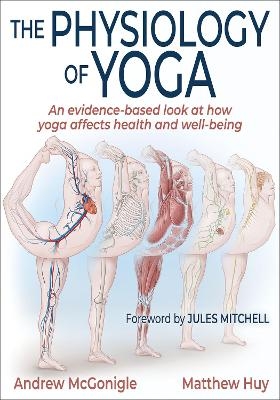
The Physiology of Yoga
Human Kinetics (Verlag)
978-1-4925-9983-8 (ISBN)
While many people practice yoga simply because it helps them feel good, the physiological basis for yoga’s effects on the body and mind is often unknown or misunderstood. Understanding these physiological concepts can help to deepen your yoga practice.
The Physiology of Yoga separates speculation from fact by examining how the body responds and adapts to yoga within many systems of the body: musculoskeletal, nervous, respiratory, cardiovascular, lymphatic, immune, endocrine, reproductive, and digestive. Straightforward explanations guide you in sorting through conflicting information about what yoga really can help you achieve and in evaluating whether certain yoga methods provide benefits to any or all of those systems.
You can experiment with concepts through Try It Yourself sidebars, which focus on mindful movement, meditation, and breathing. The 14 Myth or Fact sidebars explore popular claims about yoga, such as whether a shoulder stand can stimulate the thyroid or if twists can detoxify the liver. You’ll get the most current research to determine the validity of various claims so you can avoid practices that could be harmful or counterproductive and can decide for yourself what works for your practice.
Finally, experience firsthand how yoga affects your physiology by exploring specific yoga poses and four sequences. Each sequence explains which of the physiological principles from the earlier chapters may be most prevalent in that sequence.
With The Physiology of Yoga, you or your students can navigate all the conflicting views and opinions about the impact of yoga and learn to practice yoga while fully enjoying the benefits of mindful movement.
Andrew McGonigle has been practicing yoga and meditation for over 15 years and teaching yoga since 2009. He teaches anatomy and physiology in many yoga teacher training courses and leads his own international workshops. Although McGonigle studied anatomy in great detail during medical school, he learned to look at it from a different angle and create ways to make it relevant to yoga. He enrolled in hands-on dissection classes focused on fascia and spent his spare time rereading anatomy books, listening to podcasts, and talking about anatomy with anyone who would listen. McGonigle previously contributed a monthly article to Om Yoga & Lifestyle magazine (“360° Yoga With Doctor Yogi”) and wrote two chapters for Yoga Teaching Handbook: A Practical Guide for Yoga Teachers and Trainees. He is also the author of Supporting Yoga Students With Common Injuries and Conditions. McGonigle resides in Los Angeles. Matthew Huy (pronounced “hooey”) has been teaching yoga since 2005. He teaches anatomy and physiology in many teacher training courses in addition to providing mentoring and professional development workshops to yoga teachers. While studying biology in college, Huy discovered the joy of movement when he enrolled in a dance class and then a yoga class. A few years later, he changed tack and went on to complete a bachelor of arts degree in dance from California State University at Long Beach and completed teacher training courses in yoga, Pilates mat work, TRX, and Thai yoga massage. In 2021, he completed a master of science degree in sport, health, and exercise science at Brunel University at London, where he focused on exercise physiology and pain science. His master’s research centered on the impact of yoga teachers’ language on their students. Huy resides near London in the United Kingdom.
Chapter 1. Musculoskeletal System
Bone
Joints
Muscles
Cartilage
Tendons, Ligaments, and Aponeuroses
Fascia
The Science of Stretching and Flexibility
Pathologies, Injuries, and Conditions
Conclusion
Chapter 2. Nervous System
Cells of the Nervous System
Central Nervous System
Peripheral Nervous System
Nervous System Conditions
Conclusion
Chapter 3. Respiratory System
Anatomy and Physiology of the Respiratory System
The Biomechanics of Quiet Breathing
All About the Diaphragm
Forced Exhalation and Inhalation
Atmospheric Air and Expelled Air
Good, Wholesome Oxygen?
Ujjayi Breathing
Nose Breathing and Mouth Breathing
The Psychological and Physiological Effects of Pranayama and Slow Breathing
Pathologies and Conditions of the Respiratory System
Conclusion
Chapter 4. Cardiovascular System
Blood
Heart
Circulation
Role of the Cardiovascular System in Maintaining Homeostasis
Resting Heart Rate and Cardiac Output
Heart Rate Variability
Blood Pressure
Cardiovascular Conditions
Conclusion
Chapter 5. Lymphatic and Immune Systems
Lymphatic System
Immune System
Conclusion
Chapter 6. Endocrine System
What Is a Hormone?
Cortisol: The Master Hormone
Insulin
Thyroid Hormones
Endorphins: Our Body’s Morphine
Dopamine
Pathologies
Conclusion
Chapter 7. Reproductive System
Female Reproductive System Anatomy
Female Reproductive System Physiology
Male Reproductive System
Reproductive System Conditions
Conclusion
Chapter 8. Digestive System
Anatomy and Physiology of the Digestive System
Diet and the Digestive System
Pathologies and Gastrointestinal Problems
Conclusion
Chapter 9. Practice With Confidence
Strong, Dynamic Practice
Slow Hatha Practice
Chair Yoga Practice
Restorative Yoga Practice
Conclusion
| Erscheinungsdatum | 23.06.2022 |
|---|---|
| Vorwort | Jules Mitchell |
| Verlagsort | Champaign, IL |
| Sprache | englisch |
| Maße | 178 x 254 mm |
| Gewicht | 635 g |
| Themenwelt | Studium ► 1. Studienabschnitt (Vorklinik) ► Anatomie / Neuroanatomie |
| Studium ► 1. Studienabschnitt (Vorklinik) ► Physiologie | |
| Naturwissenschaften ► Biologie | |
| ISBN-10 | 1-4925-9983-2 / 1492599832 |
| ISBN-13 | 978-1-4925-9983-8 / 9781492599838 |
| Zustand | Neuware |
| Haben Sie eine Frage zum Produkt? |
aus dem Bereich


